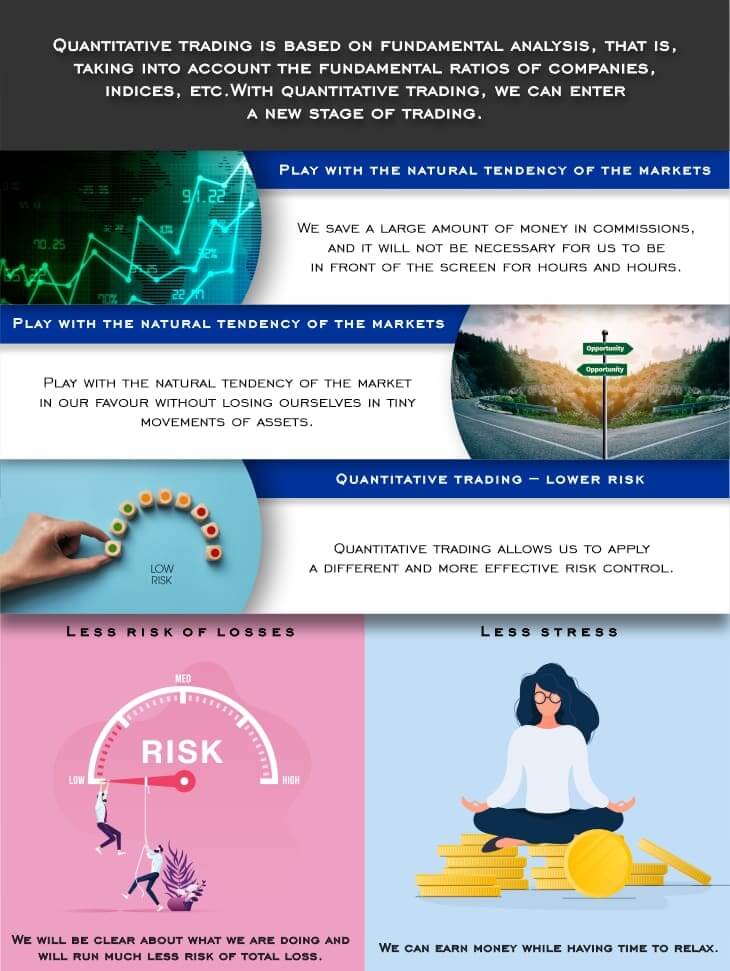
Why Does Quantitative Trading Improve Technical Analysis?
Quantitative trading is based on fundamental analysis, that is, taking into account the fundamental ratios of companies, indices, etc.
Our objective when we start trading can be to obtain good short-term profit. But, as time goes by, we will realize that we must look for formulas that allow us to obtain high recurring returns because that is the only way to become successful investors.
Understanding quantitative trading
A quantitative trading system consists of strategies based on quantitative analysis, relying on mathematical computations and numbers to identify good trading opportunities. Price and volume are the most common data inputs used in quantitative analysis as the primary inputs to mathematical models.
Financial institutions and hedge funds generally use quantitative trading, so the transactions are usually significant. They may involve purchasing and selling thousands of shares, bonds and other securities. Still, quantitative trading is becoming more commonly used by individual investors.
Quantitative traders take advantage of modern technologies, mathematics, and the comprehensive databases available for making rational trading decisions.
Quantitative traders use the trading technique and create mathematical models, and then develop a computer program that applies the developed model to historical market data. The model is then back tested and optimized. The quantitative trading system is implemented in real-time market conditions with real capital if favourable results are achieved.
Quantitative trading models
The best way to describe how quantitative trading models work is using an analogy. Consider a weather report where a meteorologist forecasts a 90% chance of rain while the sun is still shining. The meteorologist derived this counterintuitive conclusion by collecting and analyzing climate data from sensors throughout the area.
A computerized quantitative analysis shows specific patterns in the historic data collected. When these patterns are compared to the same patterns from the historical climate data, and if in 90 out of 100 times the result is rain, we can assume with a 90% chance of being right that there will be rain. Quant traders apply these same principles to the financial market to make trading decisions.
In quantitative trading, backtested data are applied to various scenarios to help identify profit opportunities. The advantage of quantitative trading is that it allows for optimal use of available data and eliminates emotional decision-making during trading.
With quantitative trading, we can enter a new stage of trading. It will allow us:
Pay less commissions
Quantitative trading strategists are extremely profitable, but they do not force us to carry out a multitude of operations. Thereby, we save a large amount of money in commissions. And it will not be necessary for us to be in front of the screen for hours and hours.
We will gain a perspective on market movements. As we analyze situations better, our work as traders will be more accurate and profitable. It is surprising to see how profitable strategies cease to be profitable when we add the buying and selling costs.
Play with the natural tendency of the markets
As every investor knows, the natural trend of the market is upward. A rational market should rise by the same percentage that the growth of the economy does. However, the market is not rational. When the economy grows and develops, companies grow with it and earn money. Therefore, making the price of shares rise as well.
Obviously, this is not the case for all companies, as some are poorly managed, have made bad decisions or are in sectors in decline due to technological changes.
The smart thing is to play with the natural tendency of the market in our favour without losing ourselves in tiny movements of assets.
Quantitative trading allows us to take advantage of the natural trend of the market by making us see the big picture, and we can base the benefit of our investments on solid and reliable foundations.
Take advantage of many more opportunities
Usually, trading strategies are based on working on a single advantage of intraday, daily, weekly movements etc. This is a great limitation for the investor who loses sight of the great possibilities created every day in the market.
By allowing us to look at the bigger picture, quantitative trading enables us to take better advantage of market opportunities, capture the profitability that the irrationality of the market offers today wherever it occurs.
Use the same possibilities for leverage and small profits:
We are not giving up leverage and small profits. Thanks to products such as CFDs, we can apply as high levels of leverage to our quantitative trading portfolios as we want. So, we will be able to obtain the same short-term benefits that we get with less-developed trading strategies.
Quantitative trading – lower risk
The most important thing for a trader is to control the risk of his operation.
Quantitative trading allows us to apply a different and more effective risk control. We will have:
Less risk of losses
By working with investment portfolios instead of a simple underlying and conforming these portfolios according to strategies tested in a 15-year backtest, we will be clear about what we are doing and will run much less risk of total loss in our investments.
Less stress
If you play with the natural tendency of the stock market and stopping getting lost and blinded by small movements in one direction and the other, you can earn money but also have time to relax.
Also, by knowing the behaviour of our strategy in the 15-year backtest, it is easier for us to trust what we do and not get carried away by stress and anxiety when things do not work out as we wish.
For all these reasons, Quantitative trading based on fundamental analysis solves many of the problems of trading based on technical analysis. It is capable of generating high returns while controlling risks despite being unknown.

Post this infographic to your site:
-
Support
-
Platform
-
Spread
-
Trading Instrument




